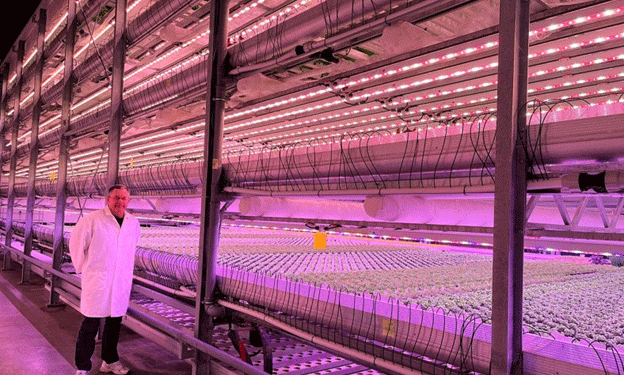Vertical farming offers tremendous potential for sustainable food production with limited water, no soil, and year-round yields. However, the financial viability of these farms remains challenging. Zeste Farms, founded by Stan Kaplita during the onset of the COVID-19 pandemic, took a unique approach by prioritizing practical, farmer-centric solutions over intricate engineering. By designing their system for ease of maintenance and low operational costs, Zeste Farms addresses one of the most pressing issues in CEA today: balancing technological innovation with traditional farming principles.
A Simple, Cost-Effective Production System
Kaplita’s initial experience in product development for Coca-Cola and Microsoft brought valuable insights to his approach at Zeste Farms. Drawing on his experience in optimizing costs, he identified a need for streamlined systems in CEA that rely on readily available parts and minimized automation to reduce both upfront costs and long-term expenses. At Zeste Farms, the “Anaconda” system was developed as a simple, modular vertical farm design that prioritized ease of operation and repair, making it accessible to those without an engineering background.
One key aspect of Zeste’s success has been working with trusted suppliers and integrating robust U.S. and European production technologies. Kaplita emphasizes that being cross-trained in every aspect of the farm—from food safety to repairs—empowers team members, promotes reliability, and ensures fewer delays due to system complexity or supply chain issues.
Navigating Market Challenges with a Farmer’s Perspective
Zeste Farms’ approach is firmly grounded in understanding market demands before scaling up production. Unlike many new CEA ventures, which prioritize rapid growth funded by venture capital, Zeste has remained focused on mastering their current scale before expanding. Kaplita stresses that product-market fit and customer alignment are critical, as vertical farms rely on steady sales to fund ongoing operations and expansion. He cautions that starting with smaller-scale production allows for adjustments in response to market demands, a lesson hard-learned by other CEA companies forced to redesign after failing to reach profitable volumes.
Location and supply chain logistics also play a major role in Zeste’s strategy. Because perishable goods like leafy greens and herbs need to reach consumers quickly, proximity to urban centers can make or break profitability. Factors such as energy costs, market access, and climate conditions all influence whether a greenhouse or indoor vertical farm is the better choice.
Learning from Greenhouse and Field Agriculture
According to Kaplita, many challenges that vertical farms face—such as food safety, water management, and transport logistics—are common across agricultural systems. By learning from traditional greenhouse growers, who have long dealt with similar issues, vertical farms can adopt practices and insights that have proven successful in the past. For example, Zeste’s team consulted experienced greenhouse designers to optimize the Anaconda system’s production efficiency while reducing costs.
The production of greens and other high-demand produce must be balanced against razor-thin profit margins, and understanding this reality is essential for new CEA ventures. This insight led Kaplita to avoid directly competing in the crowded market for salad greens, opting to produce niche crops that can sustain better margins.
Zeste Farms’ journey highlights the importance of thinking like a farmer first and an engineer second when venturing into vertical farming. Kaplita’s experience shows that CEA success doesn’t lie solely in sophisticated technology but in practical, scalable operations that adapt to market demands. For aspiring vertical farmers, aligning production systems with customer needs, focusing on simplicity, and integrating lessons from traditional agriculture can offer a more sustainable path forward.
In the evolving landscape of vertical farming, success favors those who balance innovation with practicality. With a deep understanding of agriculture’s economic challenges and a focus on serving local markets, vertical farms like Zeste can create sustainable growth that benefits both producers and consumers.









